Basements, often the mysterious corners of our homes, can hide a sneaky problem: moisture. This quiet troublemaker hides in the dark, causing mold, damaging wood, and even sparking allergies. But worry not! We’re here to tackle the dampness with our list of the best dehumidifiers for basement, your defense against this watery threat.
While all dehumidifiers help lower humidity levels in your home, those designed for basements are specifically tailored for larger, damp spaces that tend to be cooler than other areas of your house. Adding a basement dehumidifier can not only prevent mold growth but also improve overall air quality and safeguard stored items like holiday decorations or clothing.
The ideal humidity level ranges between 40 to 60 percent, though it may vary depending on the room’s location within your home. Basements, especially those below ground level, typically have higher humidity levels.
We conducted a thorough test of 17 best dehumidifiers for basement over four months, considering options suitable for both finished and unfinished basements of various sizes and moisture levels.
Throughout our testing, we favored dehumidifiers with continuous drainage systems, as they saved us time by eliminating the need for constant monitoring or tank emptying, even during especially humid periods.
We assessed each basement dehumidifier based on its effectiveness, setup, design, features, and value, presenting here the top choices for different basement types.

| Category | Model |
| Best Overall | Midea 50-Pint Cube Dehumidifier |
| Best Budget | Amazon Basics Dehumidifier |
| Best Smart | Honeywell 30-Pint Smart Dehumidifier |
| Best With Drain Hose | GE Dehumidifier with Built-in Pump |
| Best With Pump | Frigidaire 50-Pint Dehumidifier with Built-In Pump |
| Best Large | hOmeLabs 50-Pint Dehumidifier |
| Best Small | Pure Enrichment PureDry Deluxe Dehumidifier |
1. Midea 50-Pint Cube Dehumidifier

| Tank Size | 34 pints |
| Capacity | 50 pints per day |
| Coverage Area | 4,500 square feet |
| Drainage Style | Collection tank and drainage hose |
| Dimensions | 14.45 x 14.76 x 14.57 inches |
| Weight | 42 pounds |
The tank size and coverage area are two important considerations when looking for the best dehumidifier for basement, particularly if you would rather not inspect the device on a regular basis. Capable of collecting about 50 pints of water each day from the air, covering a space of about 4,500 square feet, this Midea choice is a true “set it and forget it” device. Of all the dehumidifiers we evaluated, its 34-pint collecting tank is the biggest, but you also have the option to use the provided drainage line to continually empty the device into a nearby drain.
With the help of the comprehensive instructions, assembling the device was easy and took us about five minutes. The machine included helpful stickers that walked us through the configuration procedure, even if certain options weren’t immediately obvious, like the continuous mode that required holding down two buttons.
As soon as the unit started operating, it was silent, which was a big help for those who lived in their basements as it allowed us to watch TV and have talks without being too disturbed. The dehumidifier has a tiny window that makes it simple to see how much water it has accumulated. It will also notify you when the tank needs to be emptied. If you don’t often visit your basement, you can even use your smartphone to remotely monitor the humidifier by connecting it to your Wi-Fi.
Monitoring the filter is hassle-free as it just fits into a space on the flank of the device. We only had to preen the filter onetime after using it continuously for three months. We did catch some mold accumulation in the bucket, but it was easily wiped away.
Emptying the tank wasn’t an issue, even with its big size. Although we thought the included hose was a little short, we nevertheless used a garden hose in its place if you like continuous draining. We required a separate location to keep the tank. Thus, the idea of conserving space was moot when we were unable to nestle the unit into the collecting tank while the drainage line was secured.
Throughout the three months of our testing, we had no problems using the drainage hose.
Pros
- With a 4,500 square foot coverage area, this dehumidifier is ideal for the majority of basements.
Cons
- The drainage hose is rather short.
2. Amazon Basics Dehumidifier
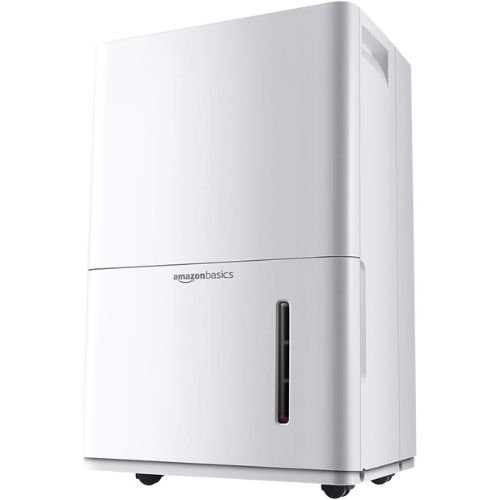
| Tank Size | 12.72 pints |
| Capacity | 35 pints per day |
| Coverage Area | 2,500 square feet |
| Drainage Style | Collection tank and drainage hose |
| Dimensions | 15.43 x 24.25 x 11.1 inches |
| Weight | 39.2 pounds |
This Amazon Basics dehumidifier is a great option for basements, particularly if you’re on a tight budget, even while it may not have all the glitzy smart features you’ll find in other versions. It has adequate power for most basement areas, covering a space of approximately 2,500 square feet and drawing about 35 pints of water every day. The speed and efficiency with which it dried the air, making it seem considerably fresher in only thirty minutes, really surprised us.
After we set it up, it took us not more than 5 minutes to have the dehumidifier operating. Even though it took an additional fifteen minutes to go through the user manual and understand every button, after we figured it out, we felt comfortable using the device.
It was loud when we initially turned it on, which is a problem for those who enjoy entertaining in their basements. However, the noise may not be a huge deal breaker if you don’t spend plenty of time down there.
We experimented with the dehumidifier in an enclosure that often experiences condensation, which leads to water dripping through the window panes in the morning. We were delighted to see the windows perfectly dry after only 1 night of usage. Each time we operated the dehumidifier, we saw a noticeable reduction in humidity within thirty minutes. Our hygrometer indicated a fall of about ten percent, and the air seemed significantly crisper. We really liked how the hygrometer on the device corresponded to our external one every time.
It was painless to empty the tank, and we admired that the collecting tank had a convenient glass that let us monitor its level. You can utilize the provided drain pipe for continuous draining. It was easy to clean the filter, and the device has LED indications to warn you when the tank and filter require maintenance.
Pros
- The speed at which it eliminates moisture is amazing.
Cons
- The noise level was too high for a comfortable discussion during testing.
3. Honeywell 30-Pint Smart Dehumidifier
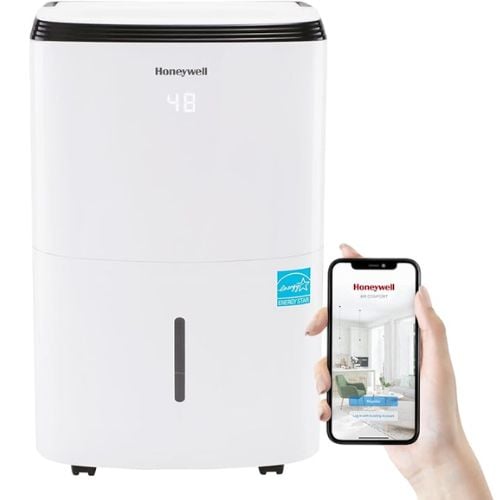
| Tank Size | 7 pints |
| Capacity | 32 pints per day |
| Coverage Area | 3,000 square feet |
| Drainage Style | Collection tank and drainage hose |
| Dimensions | 20.1 x 13.2 x 10.5 inches |
| Weight | 37 pounds |
We wholeheartedly endorse this Honeywell model if you’re looking for a strong dehumidifier with a ton of useful features. With the help of the Honeywell app, you can easily operate and monitor it from your smartphone and have it synchronized with Amazon Alexa.
Compared to the other versions we tried, the device’s setup took the longest—about 20 minutes—but it went smoothly and without any problems. Its convenient wheels, integrated handle, and lightweight design make it effortless to haul about as required. We almost immediately saw an obvious increase in the quality of the air once we started it working.
This gadget has several useful features, including auto-restart, auto-defrost, sleep mode, and automated shut-off, in addition to its two fan settings. The Honeywell app makes it simple to control each of them. You can also monitor the moisture levels using the app, and it will inform you when it’s time to empty the tank. Don’t worry if you don’t want to operate the app. It will alert you when the tank needs care or is full by beeping and flashing a red light.
The dehumidifier’s collecting tank can only contain seven pints of water, despite the fact that it can remove up to 32 pints of moisture each day and cover a large area of up to 3,000 square feet. This is why it’s advisable to utilize the included drain line for continuous draining so you won’t have to bother about manually unloading the tank.
Pros
- Its wheels and integrated handle allow for easy movement around your house.
Cons
- Given the tiny size of the collecting tank, it is best to use a drainage line.
4. GE Dehumidifier With Built-in Pump

| Tank Size | 15 pints |
| Capacity | 50 pints per day |
| Coverage Area | 4,500 square feet |
| Drainage Style | Collection tank and drainage hose |
| Dimensions | 14.76 x 24.02 x 11.38 inches |
| Weight | 43.7 pounds |
A dehumidifier with a drain hose is something you should look at if you want it to run constantly. This GE option has an integrated pump to expedite water drainage in addition to a hose. If you have a large basement to cover, this is ideal for those who don’t want to deal with the inconvenience of having to empty a collecting tank on a regular basis.
Although we had to wait an entire day after unpacking it before switching it on, as instructed in the handbook, setting up the gadget was rather simple. However, once we started it on a wet day, the air quality significantly improved after only 13 hours, and the 15-pint collecting tank was already full.
An in-built timer, frost management sensors, and a fan are just a few of the helpful features that come with the dehumidifier. It can extract up to 50 pints of water each day and cover surfaces up to 4,500 square feet. The only drawback we could find was that it is somewhat noisy, so anyone who often spends time in their basements could find it unsuitable.
It was quite easy to wash the filter; all we needed was water and soap. In addition to being efficient, the unit’s unique color, in contrast to other dehumidifiers, which are often white, makes it a fantastic choice for concealing stains and integrating them into dimmer basements.
Pros
- Compared to standard white units, its dark gray color may prove more effective in hiding stains.
Cons
- In our testing, we discovered that it was among the loudest choices.
5. Frigidaire 50-Pint Dehumidifier with Built-In Pump
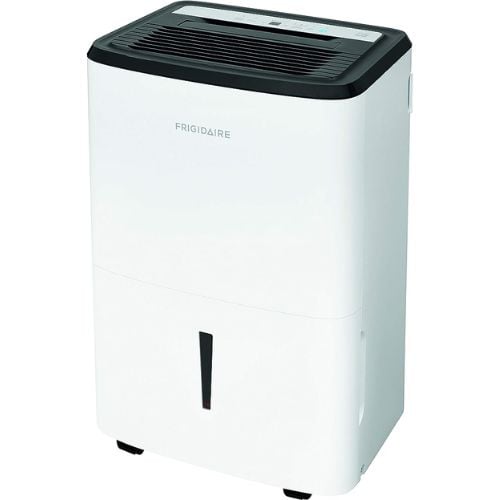
| Tank Size | 16.9 pints |
| Capacity | 50 pints per day |
| Maximum Room Size | 1,500 square feet |
| Drainage Style | Collection tank and drainage hose |
| Dimensions | 16 x 24.75 x 12.75 inches |
| Weight | 41 pounds |
This best dehumidifier with pump for basement is a good option if you need a continuous drainage pump but don’t have a floor drain. Instead of depending only on gravity, a pump lets you guide the drain line into a sink or upward via a window.
However, keep in mind that this model does not have a drain hose; thus, you will need to buy one individually or utilize a regular garden hose. Although it weighs 47 pounds, making it one of the larger models on our checklist, setting it up was quite simple. You may need assistance pulling it out of the box. It is easy to move about, however, since it has integrated wheels and a handle.
Even though we had a washing machine and sump pump in the basement throughout our testing, we saw a noticeable reduction in humidity in the room in a matter of hours. Since the tank on this item lacks a solid grip and the water did not flow out properly, we advise utilizing a drain hose with it.
Pros
- In our tests, we found that the integrated hygrometer was accurate.
Cons
- It includes a pump, but it doesn’t come with a drain pipe, so you’ll have to buy one separately.
6. HomeLabs 50-Pint Dehumidifier
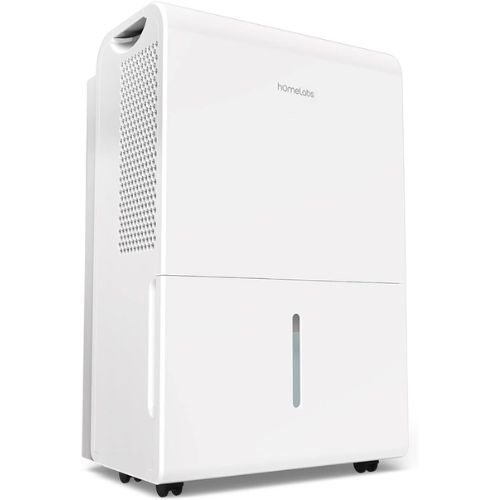
| Tank Size | 12.8 pints |
| Capacity | 50 pints per day |
| Coverage Area | 4,500 square feet |
| Drainage Style | Collection tank |
| Dimensions | 15.4 x 24.3 x 11 inches |
| Weight | 40 pounds |
You should choose a dehumidifier with broad coverage for huge basements, such as this one from hOmeLabs. With its capacity to handle 4,500 square feet and daily moisture removal of 50 pints, it is an ideal solution for dealing with basement humidity.
It took us about 5 minutes to set this best dehumidifier for large basement. However, it did need two people to get it out of the package. After reading the directions, we were able to operate it and discovered that the settings were simple to understand. We tried it in several locations around our house, and our basement showed the greatest improvement. The basement seemed a lot less stuffy after almost a whole day, particularly on warm days.
The collecting tank can contain about thirteen quarts of water, so we decided to empty it by hand. Depending on the environment and weather, it only needed draining every 11 to 24 hours. This was a significant improvement over our previous smaller dehumidifier, which required emptying every eight hours. To eliminate manual emptying, you may also attach a drain pipe if you’d like, but you’ll need to purchase the hose separately.
The handbook advises using a little detergent to wash the tank after every 2 weeks. We didn’t see any accumulation even after 2 weeks of consistent usage. As we carried out further tests, we only cleaned the tank every few weeks. The filter performed well in collecting dust and dog hair, and it was simple to clean with a vacuum.
Just bear in mind that this huge dehumidifier isn’t ideal for homes smaller than 3,000 square feet. But the additional electricity is well worth it if your basement is large.
Pros
- With the dehumidifier running at a high speed, we discovered that we just need a daily tank empty.
Cons
- This dehumidifier isn’t recommended for spaces smaller than 3,000 square feet.
7. Pure Enrichment PureDry Deluxe Dehumidifier
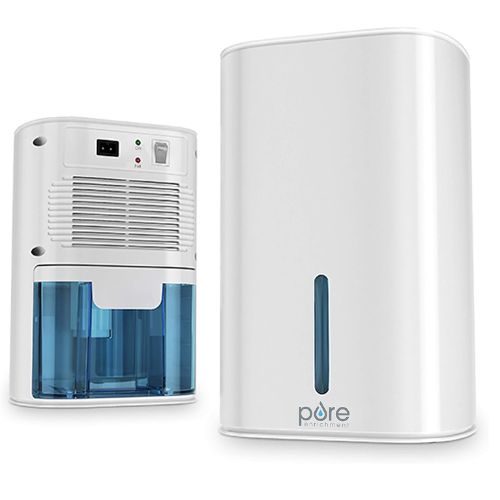
| Tank Size | 3.17 pints |
| Capacity | 1.25 pints per day |
| Coverage Area | 160 square feet |
| Drainage Style | Collection tank |
| Dimensions | 5.5 x 12 x 9.1 inches inches |
| Weight | 5 pounds |
This Pure Enrichment dehumidifier can cover up to 110 square feet and store 1.6 pints of water. It is, therefore, perfect for smaller basement spaces. We appreciated its lightweight design and found it to be highly effective throughout testing.
Apart from unpacking, it was ready to use directly out of the package, so setting it up was easy. The 3 buttons at the top were simple to use, and the directions were clear. You can program it to run constantly or on a timer for 4 or 8 hours. You can pick between two speeds: high and low. It doesn’t come with a drain line, but it automatically turns off when the tank is full to stop leaks.
It produced a gentle, unobtrusive light while in operation, and it was silent—much like a white noise machine. It was simple to tell when the clear tank needed to be emptied, and cleaning it was simple. For those looking for low-maintenance appliances, it’s also wonderful that there is no filter to clean or replace.
Pros
- The transparent collection tank allows you to easily see when it’s time to empty it.
Cons
- You’ll need to purchase a drain hose separately as it’s not included.
8. Eva-Dry Electric Petite Dehumidifier

| Tank Size | 1 pint |
| Capacity | 0.5 pints per day |
| Coverage Area | 122 square feet |
| Drainage Style | Bucket |
| Dimensions | 5.3 x 6.5 x 11 inches |
| Weight | 1 pound |
An excellent option for dealing with moisture in confined locations such as crawl spaces or tiny basement rooms is this dehumidifier. Its small size and powerful design wowed us throughout testing. It’s also the most affordable choice on our list. Coming in at around $60. It’s ideal if you’re on a tight budget and just need it sometimes. Furthermore, it is very portable at less than 4 pounds in weight.
Our little 10 × 10-foot basement dried out pretty well with the help of this little device. It’s easy to operate. Even without fancy additions like a pump or drain system. Moreover, due to its one-switch operation and a useful tank indication light. Because of its tiny size and low weight, the clear tank makes it easy to monitor the water level and is easy to empty and clean. There is no need to deal with a filter. Its quiet operation makes it ideal for use in a small space without making a lot of noise.
But this may not be your greatest option if you have to cope with a really wet or humid environment. While our top selection can manage up to 35 quarts of moisture per day, this one can only remove approximately half that amount. However, it’s a winner for relatively compact places or infrequent usage.
Pros
- Easy to carry around due to its portability and lightweight design. Works effectively in small spaces.
Cons
- Doesn’t display the humidity level.
9. Frigidaire 35-Pint Dehumidifier

| Tank Size | 2.11 Gallons |
| Capacity | 35 Pints |
| Coverage Area | 4500 square feet |
| Drainage Style | Collection tank and drainage hose |
| Dimensions | 12.19 x 15.97 x 24.25 inches inches |
| Weight | 40 pounds |
We suggest the Frigidaire 35 Pint Dehumidifier for both finished and unfinished basements. Whether or not you have a drain, it’s a great option. Its bigger water tank and continuous drain mechanism make it adaptable for usage in very humid areas.
We tested this device in a 700-square-foot damp basement with a sump pump and washing machine that caused temperature and moisture levels to fluctuate. It amazed us by lowering the humidity so fast that it even dried up wet spots on the floor.
It’s easy to empty the water bucket. It includes a carrying handle and a splash guard to stop spillage and is conveniently positioned. It also has a dust-capture filter, which enhances efficiency and air quality. Cleaning the filter is simple. Simply take it out, give it a wash, and put it back in as suggested every two weeks.
We had even better outcomes when we changed to a continuous drain system and directed water into our floor drain. It more successfully maintains the optimal humidity level while running continuously. Please be aware that this function requires the purchase of a separate hose. However, having the freedom to choose the ideal hose size for your configuration is advantageous.
Additionally, you can adjust the built-in humidistat’s settings to maintain the ideal humidity level in your basement. Stick to the lowest fan setting (it’s approximately as noisy as the hum of a refrigerator) for quieter operation. It’s preferable to utilize the maximum level while you’re not in the same area, as it can be rather loud.
Pros
- Highly effective at eliminating dampness and odors. Spacious tank capacity. Washable filter for easy maintenance. Features a continuous drain system.
Cons
- Drainage hose not included. Can be noisy on higher fan speeds.
Final Verdict
We tested 17 products and discovered that the best option for basements is the Midea 50-Pint Cube Dehumidifier. During our testing, its large collecting tank and broad covering area were particularly noteworthy. The device’s ability to remove moisture was impressive. We found its user-friendly attributes to be quite beneficial. Particularly the app that allows you to scan and operate the device from any location.
Our Testing Procedure
In order to determine which dehumidifiers are ideal for basements, we conducted extensive testing on 17 well-known brands. We thoroughly evaluated each dehumidifier’s performance, design, setup procedure, features, and overall worth.
We were particularly interested in how long it took to assemble the dehumidifiers. And how simple it was to follow the construction and operating instructions when we received them. We measured the humidity levels before and after using each dehumidifier using an external hygrometer in order to assess efficacy. We also cross-referenced these data with the integrated hygrometers in the devices. We moved the dehumidifiers about our houses throughout the testing period to see how well they worked in various-sized rooms.
We assessed user-friendliness, noise levels, and maintenance needs during the testing process. We evaluated the usefulness and practicality of the smart feature models.
What to Consider Before Buying Dehumidifiers for Basements
1. Tank Size and Capacity
The capacity of a dehumidifier indicates the amount of moisture it can remove from the air on a daily basis. You’ll need a larger capacity the larger or damper your basement is. The typical range of capacities is one to sixty pints per day. However, keep in mind that the dehumidifier won’t operate at its fullest potential if the humidity level in your basement is at your ideal level.
The amount of water the unit can retain before needing to be emptied is determined by the tank size. While bigger dehumidifiers may store up to 34 pints, smaller models may only hold around 3 pints. Larger tanks need fewer emptyings since they are heavier when filled. When the tank is full, the majority of dehumidifiers incorporate automatic shut-off mechanisms or timers. To keep everything functioning properly, be sure to empty the tank every day. In case you’re depending on it rather than a drain hose.
2. Area of Coverage
When selecting a dehumidifier, take into account the size of your basement. There are 500–1,500 square feet in a basement. We provide options for areas ranging in size from 160 to 4,500 square feet. A smaller dehumidifier may be sufficient for one room, but it might not be sufficient for a whole basement.
3. Pump and Drain Hose
If you don’t want to empty the tank every day, try to get a dehumidifier with a drain hose attachment. This allows you to program it to drain continuously. However, it restricts the unit’s placement options and may need an extension cable. While not all top dehumidifiers have a hose, the majority may drain constantly. Use a regular garden hose or purchase these hoses from hardware shops.
The majority of dehumidifiers depend on gravity to drain water downward since they lack a pump. A dehumidifier with a pump is required if you want to drain into a sink or do not have a floor drain. These may be louder than regular ones and are more expensive.
In Case You Missed It!

